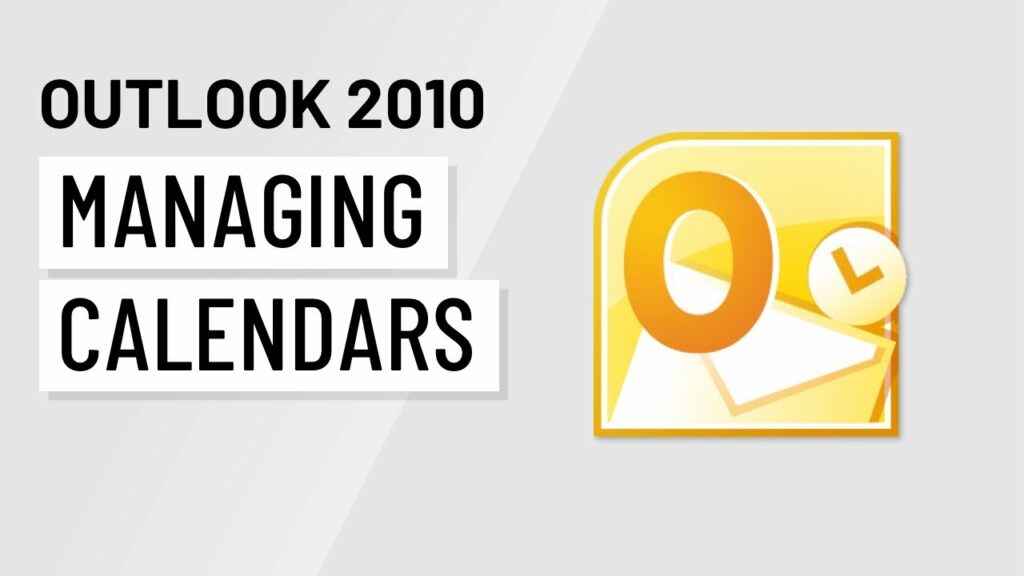Mastering Calendar Management in Outlook 2010: A Comprehensive Guide

Introduction:
In the realm of productivity tools, few are as essential as the calendar. Microsoft Outlook 2010 offers a robust set of features for managing calendars, helping users stay organized, schedule appointments, and coordinate meetings with ease. Whether you’re a busy professional juggling multiple commitments or an individual managing personal events, mastering calendar management in Outlook 2010 can significantly enhance your productivity and time management skills. In this comprehensive guide, we delve deep into the intricacies of managing calendars in Outlook 2010, providing invaluable insights and strategies for optimizing your scheduling workflow.
Section 1: Getting Started with Calendars
1.1 Calendar Views: Outlook 2010 offers multiple calendar views to suit different scheduling needs. Users can choose between Day, Week, Month, and Schedule views, each providing a unique perspective on their upcoming events and appointments. Customizable layout options allow users to tailor their calendar views to their preferences.
1.2 Creating New Appointments: Creating new appointments in Outlook 2010 is simple and intuitive. Users can navigate to the Calendar module and click on the “New Appointment” button to initiate the process. The appointment form allows users to enter details such as title, location, date, time, and attendees, ensuring all necessary information is captured.
1.3 Recurring Appointments: For recurring events such as weekly meetings or monthly appointments, Outlook 2010 offers the option to create recurring appointments. Users can specify the recurrence pattern, frequency, and end date for recurring appointments, saving time and effort in scheduling repetitive events.
1.4 Setting Reminders: Reminders in Outlook 2010 help users stay on top of their schedule by providing timely notifications for upcoming appointments and events. Users can set reminders for individual appointments or globally configure default reminder settings for all appointments, ensuring important events are not forgotten.
Section 2: Advanced Calendar Features
2.1 Sharing Calendars: Outlook 2010 facilitates collaboration and coordination by allowing users to share their calendars with colleagues, friends, or family members. Users can grant varying levels of access permissions, such as viewing only, editing, or delegating calendar management rights. Shared calendars enable seamless scheduling and enhance communication among team members or social groups.
2.2 Overlaying Calendars: Outlook 2010’s overlay calendar feature allows users to overlay multiple calendars onto a single view, providing a comprehensive overview of their schedule. Users can overlay calendars from different sources, such as colleagues’ calendars, shared team calendars, or public holidays, enabling efficient scheduling and resource allocation.
2.3 Color Coding and Categorization: Color coding and categorization in Outlook 2010 help users visually differentiate between different types of appointments and events. Users can assign colors to categories such as work, personal, or travel, making it easy to identify and prioritize tasks at a glance. Categorization enhances organization and streamlines scheduling workflows.
2.4 Customizing Calendar Views: Outlook 2010 offers extensive customization options for calendar views, allowing users to tailor their calendar displays to their preferences. Users can adjust settings such as time intervals, start and end times, and display options to optimize their calendar layout for maximum efficiency and readability.
Section 3: Integration and Syncing
3.1 Integration with Exchange Server: Outlook 2010 seamlessly integrates with Microsoft Exchange Server, enabling real-time synchronization of calendars across multiple devices and platforms. Changes made to calendars in Outlook are automatically updated and reflected in Exchange Server, ensuring consistency and accessibility across devices.
3.2 Mobile Device Syncing: Users can sync their Outlook calendars with smartphones, tablets, and other mobile devices for on-the-go access to their schedule. Integration with Exchange ActiveSync enables real-time synchronization, keeping calendars up-to-date across all devices and ensuring users stay informed of their appointments and events wherever they are.
3.3 Third-Party Integration: Outlook 2010 supports integration with third-party calendar services such as Google Calendar and Apple Calendar, allowing users to sync their Outlook calendars with external platforms. Users can configure calendar synchronization settings to ensure seamless interoperability between Outlook and third-party calendar services, facilitating cross-platform scheduling and collaboration.
Conclusion:
Effective calendar management is key to optimizing productivity and time management in today’s fast-paced world. By mastering the features and capabilities of Outlook 2010 for managing calendars, users can streamline their scheduling workflows, stay organized, and make the most of their time. Whether you’re a professional managing work commitments or an individual coordinating personal events, Outlook 2010 provides the tools and functionalities to help you stay on top of your schedule with confidence and efficiency. By implementing the strategies and techniques outlined in this guide, users can harness the full potential of Outlook 2010’s calendar management features and achieve greater productivity and success in their daily lives.





